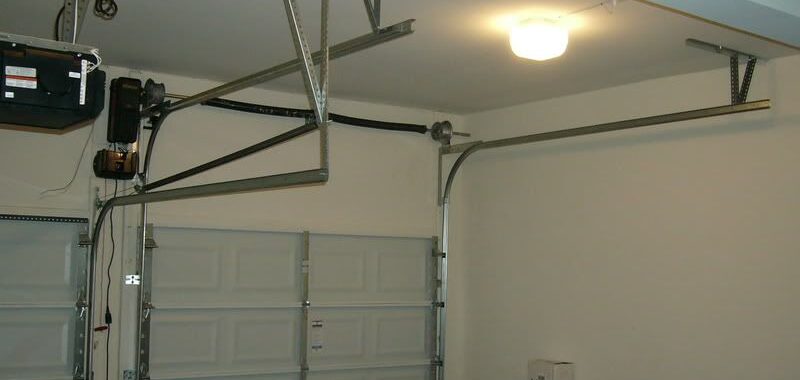If you have a garage door, you know how important it is to keep it in good working condition. A garage door that operates smoothly and safely can protect your car, your home, and your family from the elements, intruders, and accidents. But what happens when your garage door track and rail system starts to malfunction? How do you fix it and prevent further damage?
Your garage door track and rail system is the metal framework that guides the movement of your garage door. It consists of two vertical tracks, two horizontal tracks, and a curved section that connects them. The tracks are attached to the wall and the ceiling of your garage, and the rails are the metal rods that run along the tracks. The garage door rollers are the wheels that attach to the rails and allow the door to slide up and down.
When your garage door track and rail system is working properly, your garage door should open and close smoothly and quietly. But sometimes, the tracks and rails can get bent, misaligned, or damaged due to various reasons, such as wear and tear, weather, impact, or improper installation. When this happens, your garage door can get stuck, make loud noises, or even fall off the tracks. This can pose a serious safety hazard and damage your garage door and your property.
Fortunately, fixing garage door track and rail problems is not as hard as it may seem. With the right tools, knowledge, and skills, you can align and repair your garage door tracks and rails yourself, or hire a professional garage door repair service to do it for you. In this comprehensive guide, we will show you how to identify, diagnose, and fix common garage door track and rail issues, as well as provide you with some useful tips and tricks to maintain your garage door track and rail system in optimal condition.
How to Align and Repair Your Garage Door Tracks and Rails: A Step-by-Step Guide
If your garage door is off-track, you may be able to fix it yourself by following these steps:
- Disconnect the power. Before you start working on your garage door, make sure to unplug the opener from the power source and disconnect the emergency release cord. This will prevent the door from moving unexpectedly and injuring you or damaging the door.
- Inspect the tracks and rails. Look for any signs of damage, such as bends, dents, cracks, or rust. Also, check if the tracks and rails are properly aligned and parallel to each other. Use a level to measure the vertical and horizontal alignment of the tracks and rails. If you find any damage or misalignment, you will need to repair or replace the affected parts.
- Repair or replace the damaged parts. Depending on the extent of the damage, you may be able to repair the tracks and rails by using a hammer, a pair of pliers, or a metal file. You can also use a rubber mallet to gently tap the tracks and rails back into alignment. However, if the damage is too severe or the parts are broken, you will need to replace them with new ones. You can buy replacement parts from a garage door repair service or a hardware store. Make sure to buy the right size and type of tracks and rails for your garage door model.
- Reattach the door to the tracks and rails. Once you have repaired or replaced the damaged parts, you can reattach the door to the tracks and rails. You will need to lift the door and slide the rollers back into the tracks and rails. You may need someone to help you with this step, as the door can be heavy and hard to maneuver. Make sure the door is securely attached and balanced on the tracks and rails.
- Test the door. After you have fixed the garage door track and rail system, you can plug the opener back into the power source and reconnect the emergency release cord. Then, test the door by opening and closing it several times. Check if the door is moving smoothly and quietly, and if there are any gaps or misalignments. If the door is still not working properly, you may need to adjust the tension of the springs or the limit switches of the opener. You can also contact a professional garage door repair service for further assistance.
Common Causes and Solutions for Garage Door Track and Rail Issues: What You Need to Know
Garage door track and rail problems can be caused by various factors, such as:
- Wear and tear. Over time, the tracks and rails can wear out due to friction, corrosion, or exposure to the elements. This can cause them to lose their shape, strength, or alignment. To prevent this, you should regularly inspect, clean, and lubricate your tracks and rails, as well as replace any worn or damaged parts.
- Impact. Sometimes, the tracks and rails can get bent or broken due to accidental impact from a vehicle, a tool, or an object. This can cause the door to jam, wobble, or fall off the tracks. To avoid this, you should be careful not to hit or bump your garage door or its components, and keep your garage clear of any obstacles or clutter.
- Improper installation. If the tracks and rails are not installed correctly, they can cause the door to malfunction or become unstable. For example, if the tracks and rails are not level, parallel, or securely attached, they can cause the door to sag, tilt, or shake. To prevent this, you should always follow the manufacturer’s instructions when installing your garage door, or hire a professional garage door installer to do it for you.
- Temperature changes. Extreme hot or cold weather can affect the metal components of your garage door, causing them to expand or contract. This can result in the tracks and rails becoming loose, tight, or warped. To avoid this, you should adjust the tension of the springs and the limit switches of the opener according to the season, and insulate your garage door and its parts from the weather.
If you notice any of these signs of garage door track and rail problems, you should act quickly to fix them before they worsen or cause more damage. You can either try to fix them yourself by following the steps in the previous section or contact a reputable garage door repair service in your area. A professional garage door technician can diagnose and repair your garage door track and rail system efficiently and safely, saving you time, money, and hassle.

DIY Tips for Fixing Garage Door Track and Rail Problems: Save Time and Money with These Simple Tricks
If you are a handy person who likes to do things yourself, you may be interested in learning some DIY tips for fixing garage door track and rail problems. These tips can help you save time and money by avoiding unnecessary service calls or replacements. However, before you attempt any DIY repairs, you should always exercise caution and follow safety precautions. You should also have the right tools and equipment, such as a ladder, a level, a hammer, a pliers, a metal file, a rubber mallet, a wrench, a screwdriver, and some garage door roller lubricant.
Here are some DIY tips for fixing garage door track and rail problems:
- Clean and lubricate the tracks and rails. One of the easiest and most effective ways to fix garage door track and rail problems is to clean and lubricate them regularly. Dirt, dust, debris, and rust can build up on the tracks and rails, causing friction, noise, and resistance. To clean them, you can use a cloth, a brush, or a vacuum to remove any dirt or debris. Then, you can apply some garage door roller lubricant to the tracks and rails, as well as the rollers, hinges, and springs. This will reduce friction, noise, and wear and tear, and improve the performance and lifespan of your garage door track and rail system.
- Adjust the track and rail alignment. Another common cause of garage door track and rail problems is misalignment. If the tracks and rails are not level, parallel, or securely attached, they can cause the door to sag, tilt, or shake. To adjust the alignment, you can use a level to measure the vertical and horizontal alignment of the tracks and rails. Then, you can use a wrench or a screwdriver to loosen or tighten the bolts or screws that hold the tracks and rails in place. You can also use a rubber mallet to gently tap the tracks and rails back into alignment. Make sure to check the alignment after each adjustment, and repeat the process until the tracks and rails are perfectly aligned.
- Replace the damaged or worn parts. Sometimes, the tracks and rails or their components can get damaged or worn beyond repair. For example, the tracks and rails can get bent, cracked, or broken, or the rollers can get chipped, cracked, or flattened. In these cases, you will need to replace the damaged or worn parts with new ones. You can buy replacement parts from a garage door repair service or a hardware store. Make sure to buy the right size and type of tracks and rails or rollers for your garage door model. Then, you can follow the manufacturer’s instructions or watch some online tutorials to replace the parts yourself.
Conclusion
Garage door track and rail problems can be frustrating and dangerous, but they can also be fixed with some DIY skills or professional help. By following this comprehensive guide, you can learn how to identify, diagnose, and fix common garage door track and rail issues, as well as how to maintain your garage door track and rail system in optimal condition. Whether you need to align, repair, or replace your tracks and rails, you can save time and money by doing it yourself or hiring a reliable garage door repair service.
If you are looking for a garage door repair Lloydminster, you can trust Iceberg Overhead Doors to handle your garage door track and rail problems. We offer high-quality garage door installation, repair, and maintenance services at affordable prices. We have the experience, expertise, and equipment to fix any garage door track and rail problem, no matter how big or small. So contact Iceberg Overhead Doors today and get a free estimate for your garage door track and rail repair or replacement.
Frequently Asked Questions
How often should I lubricate my garage door tracks and rails?
You should lubricate your garage door tracks and rails at least once a year, or more often if you use your garage door frequently or live in a harsh climate. Lubricating your tracks and rails can reduce friction, noise, and wear and tear, and extend the lifespan of your garage door track and rail system.
How can I tell if my garage door tracks and rails are damaged or misaligned?
Some signs of garage door track and rail problems are: the door is hard to open or close, the door makes loud or unusual noises, the door shakes or wobbles, the door sags or tilts, the door gets stuck or falls off the tracks, or there are visible gaps or bends in the tracks and rails. If you notice any of these signs, you should inspect your tracks and rails and fix them as soon as possible.
How much does it cost to fix garage door track and rail problems?
The cost of fixing garage door track and rail problems depends on several factors, such as the type and extent of the damage, the size and model of your garage door, the availability and quality of the replacement parts, and the labor and service fees of the garage door repair company.









